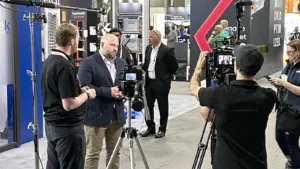Understanding Big Tech’s Newest Union: Alphabet Workers Union
In response to several high-profile scandals from the Google leadership team and a desire to have a larger voice in the workplace, hundreds of Alphabet workers have unionized under the newly-formed Alphabet Workers Union. Since its launch in early January 2021, the union has grown from 230 members to 700 members.
MarketScale’s Daniel Litwin sat down with Shaun Richman, Program Director at SUNY Empire and previous Deputy Director of Organizing for the American Federation of Teachers, to break down the reasons for the Alphabet workers’ unionization push, the strategy behind it, and how this will pressure white collar tech companies moving.
Below is a condensed transcript of Richman’s insights.
DL: Hey, everyone, this is Daniel Litwin, the Voice of B2B, coming at you from the MarketScale studio. Great to have you back on, [Sean]. How are you doing?
SR: Great to be back. Yeah, it’s a pleasure again to chat.
DL: Let’s start with getting the context for the unionization in the first place. Google employees involved in this unionization project point to several missteps by the company as motivating the decision, including things like Google’s real name policy from back in 2011, the company’s association with the Pentagon, and their drone program, millions of payouts given to executives who had been accused of sexual harassment. [and more]. Were there any other key factors that you believe led Alphabet workers to unionize?
SR: So I think what’s really awesome and radical about what the workers announced yesterday is that they have formed a union — period, full stop. They’re not going to wait for government approval. They’re not going to wait for Alphabet approval. They have formed a union. … And they’re not going to wait for all of their coworkers to agree. So, it’s a minority union, and they’re moving ahead. Their goals are not just to improve their own working standards. It is largely also to get Google to not be evil, which is the promise they were given when they were hired there.
DL: I think it’s important to also understand for listening audience that unionization in tech, especially in big tech, is sparse, to say the least. The most high-profile example of tech unionization in recent memory was a little less than a year ago with Kickstarter, which was a long, grueling process for those employees. But, eventually, they formed a union. So, based on some of your work in the past, how effective have unions been in securing labor rights for tech workers?
SR: It’s not just tech. It’s any area of the economy that has grown. Unions exist and are strong in sort of legacy areas of the economy, right? Autos, steel, public schools. And it’s because labor law is so ossified that the technical legal official process to get a union form is just wholly inadequate for a method of capitalism that is highly mobile. … What makes it really exciting and fascinating is, again, they just said, we’re a union. They might not go the route of filing petitions of using a broken system. I think they will wind up filing unfair labor practice charges against the employer. Any time that they violate someone’s union rights, they might file those charges in any country where they think they have a better venue and where it matters. And it’ll provide some very good test cases for the Biden administration’s NLRB.
DL: What sort of impact do you think this is going to have on Google’s business decisions moving forward with a more vocal and more empowered workforce? And how do you imagine Google is going to respond, especially when they receive pushback just recently, a month or so ago, for firing two workers who were organizing some major protests?
SR: All of big tech is going to be facing a lot more scrutiny from the next administration, from Congress and a lot of pushes for regulation, for breakup, for whatever the solution is. A lot of this is probably the Google bosses’ worst nightmare, that there’s an empowered group of workers who are going to be able to offer testimony and offer alternative suggestions about how Google should be regulated, and how the internet, itself, should be regulated.
Listen to the full episode for more insights and potential impacts of the formation of the Alphabet Workers Union.







